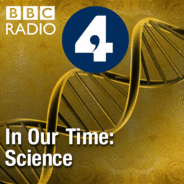Melvyn Bragg and guests discuss the voyage of HMS Challenger which set out from Portsmouth in 1872 with a mission a to explore the ocean depths around the world and search for new life. The scale of the enterprise was breath taking and, for its ambition, it has since been compared to the Apollo missions. The team onboard found thousands of new species, proved there was life on the deepest seabeds and plumbed the Mariana Trench five miles below the surface. Thanks to telegraphy and mailboats, its vast discoveries were shared around the world even while Challenger was at sea, and they are still being studied today, offering insights into the ever-changing oceans that cover so much of the globe and into the health of our planet.The image above is from the journal of Pelham Aldrich R.N. who served on the Challenger Surveying Expedition from 1872-5.WithErika Jones
Curator of Navigation and Oceanography at Royal Museums GreenwichSam Robinson
Southampton Marine and Maritime Institute Research Fellow at the University of SouthamptonAndGiles Miller
Principal Curator of Micropalaeontology at the Natural History Museum LondonProducer: Simon Tillotson

Wissenschaft & Technik
In Our Time: Science Folgen
Scientific principles, theory, and the role of key figures in the advancement of science.
Folgen von In Our Time: Science
292 Folgen
-
Folge vom 22.12.2022The Challenger Expedition 1872-1876
-
Folge vom 17.11.2022The Fish-Tetrapod TransitionMelvyn Bragg and guests discuss one of the greatest changes in the history of life on Earth. Around 400 million years ago some of our ancestors, the fish, started to become a little more like humans. At the swampy margins between land and water, some fish were turning their fins into limbs, their swim bladders into lungs and developed necks and eventually they became tetrapods, the group to which we and all animals with backbones and limbs belong. After millions of years of this transition, these tetrapod descendants of fish were now ready to leave the water for a new life of walking on land, and with that came an explosion in the diversity of life on Earth.The image above is a representation of Tiktaalik Roseae, a fish with some features of a tetrapod but not one yet, based on a fossil collected in the Canadian Arctic.WithEmily Rayfield Professor of Palaeobiology at the University of BristolMichael Coates Chair and Professor of Organismal Biology and Anatomy at the University of ChicagoAnd Steve Brusatte Professor of Palaeontology and Evolution at the University of EdinburghProducer: Simon Tillotson
-
Folge vom 27.10.2022The ElectronMelvyn Bragg and guests discuss an atomic particle that's become inseparable from modernity. JJ Thomson discovered the electron 125 years ago, so revealing that atoms, supposedly the smallest things, were made of even smaller things. He pictured them inside an atomic ball like a plum pudding, with others later identifying their place outside the nucleus - and it is their location on the outer limit that has helped scientists learn so much about electrons and with electrons. We can use electrons to reveal the secrets of other particles and, while electricity exists whether we understand electrons or not, the applications of electricity and electrons grow as our knowledge grows. Many questions, though, remain unanswered.With Victoria Martin Professor of Collider Physics at the University of EdinburghHarry Cliff Research Fellow in Particle Physics at the University of CambridgeAndFrank Close Professor Emeritus of Theoretical Physics and Fellow Emeritus at Exeter College at the University of OxfordProducer: Simon Tillotson
-
Folge vom 07.07.2022The Death of StarsMelvyn Bragg and guests discuss the abrupt transformation of stars after shining brightly for millions or billions of years, once they lack the fuel to counter the force of gravity. Those like our own star, the Sun, become red giants, expanding outwards and consuming nearby planets, only to collapse into dense white dwarves. The massive stars, up to fifty times the mass of the Sun, burst into supernovas, visible from Earth in daytime, and become incredibly dense neutron stars or black holes. In these moments of collapse, the intense heat and pressure can create all the known elements to form gases and dust which may eventually combine to form new stars, new planets and, as on Earth, new life.The image above is of the supernova remnant Cassiopeia A, approximately 10,000 light years away, from a once massive star that died in a supernova explosion that was first seen from Earth in 1690WithMartin Rees Astronomer Royal, Fellow of Trinity College, CambridgeCarolin Crawford Emeritus Member of the Institute of Astronomy and Emeritus Fellow of Emmanuel College, University of CambridgeAndMark Sullivan Professor of Astrophysics at the University of SouthamptonProducer: Simon Tillotson
